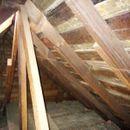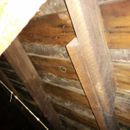Should I plan to better vent my roof later?
Hi GreenBuildingAdvisor,
I love your site. Lots of great information, and informative comments.
We just bought a 100 year old home. It is a story and a half. It has been through several renovations, many of which make me cringe. We should have bought a different house, but we were under pressure, and this will be our home for at least the next five years, if not the rest of my life (I’m 38).
So we started tearing up carpet in the master bedroom upstairs…you all know where this is going…anyways to try and make a long story short, we need to insulate the between the wall sheathing and the inside, as we discovered there is nothing but air between them in one corner at least.
The rest of the upstairs has been “renovated” and I am assuming that they put at least something between the walls before they sheeted with drywall. I am hoping to find someone to do blown in cellulose in the wall, although we do have access to the space, so we could do batts or spray foam, but my feeling is cellulose is the most economic, and environmentally friendly option.
The real question is about my roof. It is a gable roof, 12/12 pitch, and is metal, on OSB, approx 15 years old. In the attic, there is Roxul batts, nicely placed over pink fill, over wood chips. There does not appear to be any gap under the sheeting for air flow.
In the master bedroom, the slanted ceiling, on the east side will never be as accessible from the inside as it is now. I am hesitant to remove the shiplap, because in the few spots that I have wood chip insulation and pink fill have fallen out, and If I remove the shiplap I will have a big mess, but potentially access to fix the airflow issue. I am only assuming it is an issue, our first winter will tell I suppose.
My question is, since I won’t really be able to get access to the rest of the roof in this way, ie from the rooms, as we don’t plan on tearing apart the exterior walls on the inside of the other bedrooms, does it make sense to make a pathway for air movement now, or plan, down the road, when replacing the roof to install it in a way that gives it better ventilation?
I would love to one day do some exterior insulation, and create a nice air gap between the siding, and I suppose carry this up under the roofing, or maybe the attic. The attic is currently being vented with two wind turbine style roof vents, one which is not spinning very well, and there is a soffit, but as I said it is probably covered with insulation. There is no other venting, nothing on the gable ends. Nada.
If I create a clear path in one section of the roof, about half of one side, would I see any gains? I really only want to do this once, and of course right, so my question is, what is the best plan? Ideally the roof would hold snow, but that might test the limits of the framing up there, which to my lay eye is questionable. dimensional 2 x 4s that are sistered together to make the length. Ahhhhhh! Sorry for all the info, but I feel the more you know the easier it will be to provide me with advice. Thanks in advance.
Cheers,
Ben
GBA Detail Library
A collection of one thousand construction details organized by climate and house part











Replies
Ben,
Your description is a little confusing. I think I understand, but I'm not sure.
You wrote, "In the attic, there is Roxul batts, nicely placed over pink fill, over wood chips." You didn't say where this insulation is placed. Is it on the attic floor or between the rafters (along the sloping roofline)? From your photos, I'm guessing that the insulation is on the attic floor. Is that right?
You also wrote, "In the master bedroom, the slanted ceiling, on the east side will never be as accessible from the inside as it is now. I am hesitant to remove the shiplap." You didn't tell us where the shiplap boards are located. Is this the finish ceiling on the sloped section of the ceiling?
Ben,
Until I learn more about the location of your insulation, it's hard to provide advice. But in general:
1. If an older house has an unconditioned attic with insulation on the attic floor, and there are no signs of moisture problems -- no signs of mold or rot -- then there is no need to install any ventilation openings for the attic. If it's lasted a few decades already, it's fine.
2. If you have a sloped insulated roof assembly (also known as a cathedral ceiling) that is insulated between the rafters with fluffy insulation like mineral wool or fiberglass, it's essential to have a ventilation channel between the top of the insulation and the underside of the roof sheathing -- unless there is a sufficiently thick layer of rigid foam above the roof sheathing.
For more information on these issues, see this article: All About Attic Venting.
Hi Martin,
Thank you for your quick response, and the link. Very interesting. I almost feel it gives me a pass to not worry about it, especially if there are no signs of condensation issues. I might dig a little deeper just to make sure. Air tightness looks like it is the main concern. I'm not sure what I can realistically do about that right now. I have some acoustical sealant, which I plan to run between laps on the inside of the exterior wall. Maybe try that airtight drywall technique. I was hoping to make the low wall brick to add some thermal mass, but this depends on the engineering of beams that we no doubt need to put in to support that weight. Oops I've gone to far.
As for where the insulation is, it is primarily on the attic floor, but it continues down into the lower portion of the roof, blocking the soffits. Could this be considered a partial cathedral roof? There are two wind turbine vents near the ridge.
The shiplap is also on the slanted ceiling in the bedroom. It could be the finished ceiling, but I am planning on putting Comfortboard over it, and then strap and drywall, unless you guys tell me to tear out what is there and vent. So far it looks like I might be able to do a bit less work if venting is not so crucial.
Thanks again for this informative website.
Ben
Ben,
The sloped section of ceiling -- the ceiling that is evidently finished on the interior with shiplap boards -- is indeed a type of cathedral ceiling. You need to open up these rafter bays from the interior so that you can install ventilation baffles that connect the soffit area with the attic above. Then you need to re-insulate the ceiling.
Here is a link to an article that describes the work: Site-Built Ventilation Baffles for Roofs.
Martin,
Thanks again for your prompt reply. I am going to do as you suggest. Lets hope I don't drown in wood chip insulation when I remove the shiplap! Wish me luck.
Ben